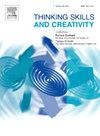Bridging disciplines: Enhancing integrative thinking via collaborative problem-based learning in higher education
IF 4.5
2区 教育学
Q1 Social Sciences
引用次数: 0
Abstract
Addressing complex challenges requires graduates with integrative thinking, a competency often underdeveloped due to disciplinary silos in higher education. This study compared the effectiveness of structured interdisciplinary Collaborative Problem-Based Learning (CPBL), featuring explicit integration scaffolding, versus a traditional collaborative model in fostering undergraduates' integrative thinking skills. Using a quasi-experimental, mixed-methods design within an interdisciplinary course, integrative thinking was assessed pre/post via a validated performance task, complemented by qualitative data from reflective journals and focus group interviews. Quantitative analysis showed the CPBL group achieved significantly greater gains in integrative thinking. Qualitative analysis revealed that structured scaffolding (particularly a mandatory framework-building phase), navigating disciplinary differences, collaborative dynamics, facilitative instruction, and developing metacognitive awareness were key factors influencing the integration process from student perspectives. Findings indicate that a holistic, structured CPBL approach is a significantly more effective pedagogy than traditional collaboration for enhancing integrative thinking, highlighting the value of intentional design with explicit support for synthesis.
桥梁学科:通过高等教育中基于问题的协作学习来增强综合思维
解决复杂的挑战需要具有综合思维的毕业生,由于高等教育中的学科竖井,这种能力往往不发达。本研究比较了以明确整合框架为特征的结构化跨学科协作性问题学习(CPBL)与传统协作学习模式在培养大学生整合思维能力方面的效果。在跨学科课程中采用准实验混合方法设计,通过验证的绩效任务评估综合思维,并辅以反思性期刊和焦点小组访谈的定性数据。定量分析显示CPBL组在综合思维方面取得了显著的进步。定性分析表明,从学生的角度来看,结构化脚手架(特别是强制性框架构建阶段)、学科差异导航、协作动力、促进教学和发展元认知意识是影响整合过程的关键因素。研究结果表明,整体的、结构化的CPBL方法是一种比传统合作更有效的教学方法,可以增强综合思维,突出了明确支持综合的有意设计的价值。
本文章由计算机程序翻译,如有差异,请以英文原文为准。
求助全文
约1分钟内获得全文
求助全文
来源期刊

Thinking Skills and Creativity
EDUCATION & EDUCATIONAL RESEARCH-
CiteScore
6.40
自引率
16.20%
发文量
172
审稿时长
76 days
期刊介绍:
Thinking Skills and Creativity is a new journal providing a peer-reviewed forum for communication and debate for the community of researchers interested in teaching for thinking and creativity. Papers may represent a variety of theoretical perspectives and methodological approaches and may relate to any age level in a diversity of settings: formal and informal, education and work-based.
 求助内容:
求助内容: 应助结果提醒方式:
应助结果提醒方式:


